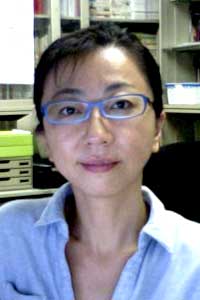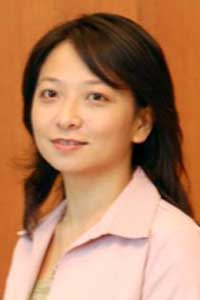:::ICCE 2011
Keynote Speakers
C1 : ICCE Conference on Artificial Intelligence in Education/Intelligent Tutoring System (AIED/ITS) and Adaptive Learning |
|

|
Kurt VANLEHN, Arizona State University, USA |
|
Title of Speech: Now that ITS are as effective as human tutors, how can they become even better? |
|
|
Abstract: It is often said that human tutors are 2 standard deviations more effective than classroom instruction and that ITS are 1 standard deviation more effective. This hypothesis, which inspired many important studies of human tutoring and many efforts to replicate human tutoring with natural language tutoring systems, now seems false. Although research continues, the current best fitting hypothesis is that both human tutors and ITS have the same effect size, namely 0.75 standard deviations above no-tutoring instruction. The first part of the talk will support this claim with a meta-analysis of relevant experiments, illustrated with specific experiments from several labs. However, this finding does not imply that ITS researchers should declare victory and retire. The studies found that both human tutors and ITS were far from perfect. ITS researchers should continue to try to achieve a 2 standard deviation effect size. The second part of the talk discusses three methods with promising preliminary results: (1) using machine learning to improve tutorial decision making; (2) teaching and fading an explicit meta-cognitive strategy; and (3) prompting reflection during problem solving. |
|
Host Country |
|

|
Tinsiri SIRIBODHI, Thailand Deputy Director for Administration and Communication of the SEAMEO Secretariat, Thailand |
|
Title of Speech: Lessons-Learned in Technology, Pedagogy and Education |
|
|
Abstract: We are now in the 21st century, we have been integrating technology in education for many centuries. With the high potential of technology to enhance and improve quality of Education, technology is considered a promising tool. What have we learned from integrating technology into Education from the past centuries? Based on the ICT in Education projects of UNESCO Asia-Pacific Regional Bureau of Education and the SEAMEO Report of ICT integration in Southeast Asian Countries, a publication of the Southeast Asian Ministers of Education Organization, this presentation will provide the synthesis of key lessons learned from integrating technology in Education in Southeast Asia region. The presentation will point out the key success factors and issues that need to be considered when integrating technology into education, particularly pedagogy. It is hope that by sharing the lessons-learned from these practices, policy makers will be able to formulate appropriate policy to support technology in education; and educators and teachers will be able to make the best use of technology to improve teaching and learning to benefit their students. |
|
C6: ICCE Conference on Technology, Pedagogy and Education |
|

|
Rose LUCKIN, University College London, UK |
|
Title of Speech: The Ecology of Resources, a Pedagogy of Plenty for Contextualized Learning |
|
|
Abstract: Particularly in the area of computer-supported collaborative learning, the methodology of social network analysis (SNA) has gained considerable attention. It has been used to identify roles and internal structures in learning groups and is an important tool to provide information and insight for managing learning communities. With a formal basis in mathematical graph theory, SNA has a long history in social psychology and sociology. Under the heading of "network science", graph-theoretical models and analyses of network structures have recently been extended beyond social networks. The extended scope includes the evolution of technical networks (such as the WWW) as well as biological or semantic networks. The model of "scale-free networks" based on the mechanism of "preferential attachment" explains important differences in the evolution of real-world networks as opposed to the characteristics of randomly wired graphs. It will be shown that these models and analytic mechanisms are also relevant in various areas of technology-enhanced learning with examples taken from semantic modeling as well as from learning and competence development in online communities. |
|
C2: ICCE Conference on Computer-supported Collaborative Learning (CSCL) and Learning Sciences |
|

|
H. Ulrich HOPPE, University of Duisburg-Essen, Germany |
|
Title of Speech: Applications and Benefits of Network Analysis in Technology-Enhanced Learning |
|
|
Abstract: The emergent research field of mobile learning has gained much attention in recent years. Since the late 90’s, a substantial number of research projects on mobile learning have been conducted in both formal and informal learning settings. The analysis of the research literature in this field indicate that much of the global research efforts have concentrated on the design and development of technological solutions to support learning about a particular subject matter. The outcomes of these research activities have contributed to a refined conceptualization of learning with mobile technologies in schools, museums and in field trips. However, fewer are the efforts reporting on the problems and limitations while introducing and adopting mobile technologies in schools or, on the different types of barriers or constraints the use of mobile devices faces in different educational settings. In this talk I will address and discuss those aspects related to innovation and sustainability in mobile learning. I will first introduce this research field in terms of perspectives and challenges in order to understand why it matters to study the sustainability of innovations in schools. Thereafter, I will turn the focus to a couple of our on-going research projects in order to provide a critical analysis on the barriers and constraints experienced by both researchers and teachers while integrating mobile devices and applications in elementary and secondary schools. Towards the end, I will discuss factors, stakeholders and lines of action identified when attempting to introduce and sustain innovative educational practices in Swedish schools. |
|
Invited Speakers
C3: ICCE Conference on Advanced Learning Technologies (ALT),Open Contents, and Standards |
|
 |
Yusuke HAYASHI, Nagoya University, Japan |
|
Title of Speech: Harmonizing content technology with standards technology |
|
|
Abstract: A conceptual framework that defines Dissemination of fine quality learning contents requires standards to exchange data as well as support for ensuring the quality of them. Currently, standards technologies have been developed by standards bodies, for example, ISO SC36, IEEE LT, IMS. These standards provide formats of data related learning contents and have been shaping the foundation to share and reuse them. For the next step, I believe it is critically important to make it easier for practitioners to access standards technologies. Concerning IMS LD, for example, it is hard for teachers to use it directly for designing lesson plans of high quality. I see there are two reasons for this. From the programming language point of view, IMS LD can be viewed as an assembly language which provides a great flexibility to express lesson plans at the cost of big effort to learn and a high possibility of producing low-quality lesson plans because of the lack of guidelines. In this talk, I discuss requirements of a high-level language for learning and instructional scenario descriptions (lesson plans) as a next-generation IMS-LD programming environment and propose a system named SMARTIES which enables teachers who do not know how to use IMS LD to describe a learning and instructional model in IMS LD. SMARTIES is an interactive system which helps lesson-plan authors break-down an abstract learning/instructional goal into executable actions interactively with useful guidance to output a high-quality learning and instructional scenario in IMS LD format. As an approach to realize this, I developed an ontology of learning and instructional theories named OMNIBUS and a theory-aware authoring system named SMARTIES with my colleagues. OMNIBUS defines concepts for organizing learning and instructional knowledge from both of theory and practice. SMARTIES helps users design learning and instructional scenarios with such knowledge modeled on OMNIBUS. Added values of SMARTIES from the viewpoint of standards technology include (1) it keeps the design rationale of learning and instructional scenarios with explicit intermediate goals of a sequence of actions and (2) it can explain many items in the scenario. I also mention my recent deployment activities of SMARTIES into a schoolteacher group in Tokyo in which SMARTIES has been extensively used to improve teachers’ lesson plans. dialog subsume cognitive processes of construction, but carried out mutually, with the potential of emergent knowledge. The ICAP hypothesis is supported by many studies from the cognitive science and learning science literature, as well as classroom studies. It also recommends appropriate control conditions for learning studies and ways that learning activities can be improved from one engagement level to another. |
|
C4: Classroom, Ubiquitous and Mobile Technology-Enhanced Learning (CUMTEL) |
|
 |
Makiko TAKENAKA, Oita University, Japan |
|
Title of Speech: Advantages of using mobile devices in learning situations |
|
|
Abstract: I present two aspects of the use of mobile devices in learning situations. The first is their use as learning tools, similar to pencils and notebooks. The learning resources are in the outside of mobile devices. Classroom teachers design lesson plans, learning strategies, and activities. Mobile devices serve as tools that support learning activities and work behind the scenes. In the research field of m-learning, although the appropriateness of the use of mobile devices as learning tools, similar to pencils, may be an open question, the features of mobile devices, such as portability and the convenience of access to a network, have a positive influence on learning. The second aspect is the construction of standard m-learning environments where learning activities can be carried out using learning resources prepared in the mobile device or obtained by communicating with the server. Almost all elements of the learning activities, such as instructions, information, and scaffoldings, are embedded within the learning contents provided by learning system constructors.
|
|
C5: ICCE Conference on Digital Game and Digital Toy Enhanced Learning and Society (GTEL&S) |
|
 |
Ju-Ling SHIH, National University of Tainan, Taiwan |
|
Title of Speech: The Praxis of Designing 3D Learning Games with the Sustainment of Theories and Strategies |
|
|
Abstract: Digital games have been used widely for the teaching and learning purposes across various fields and levels. Related research proliferated in the recent decade. Nevertheless, designing digital learning games is exceptionally different from those for commercial or entertainment purposes since educational practices require much more considerations in aspects such as learning context, content, involvement, and so forth.
|
|
